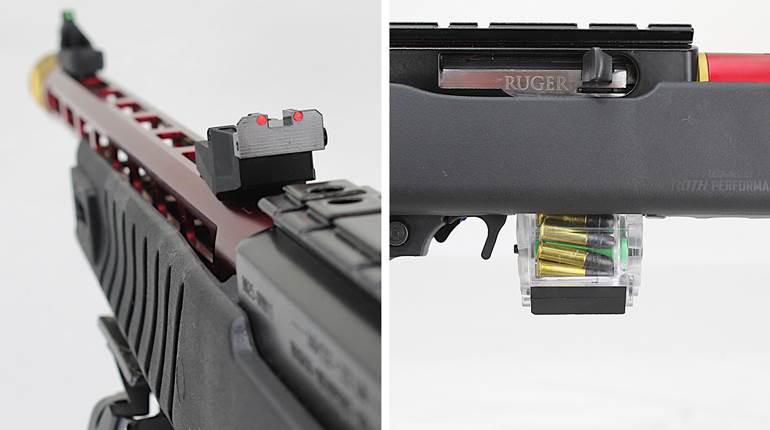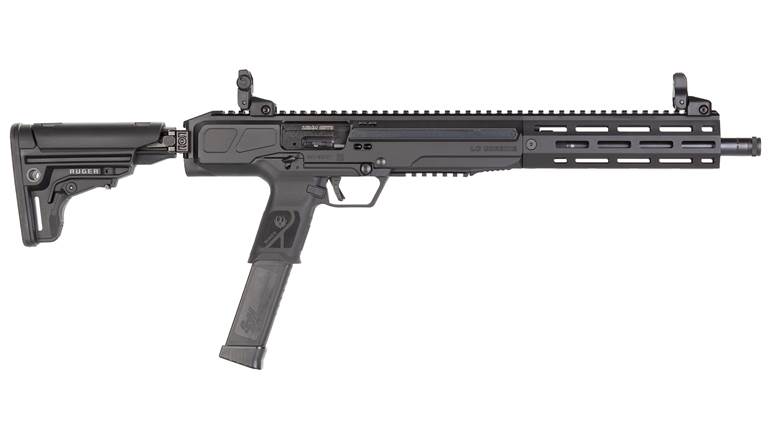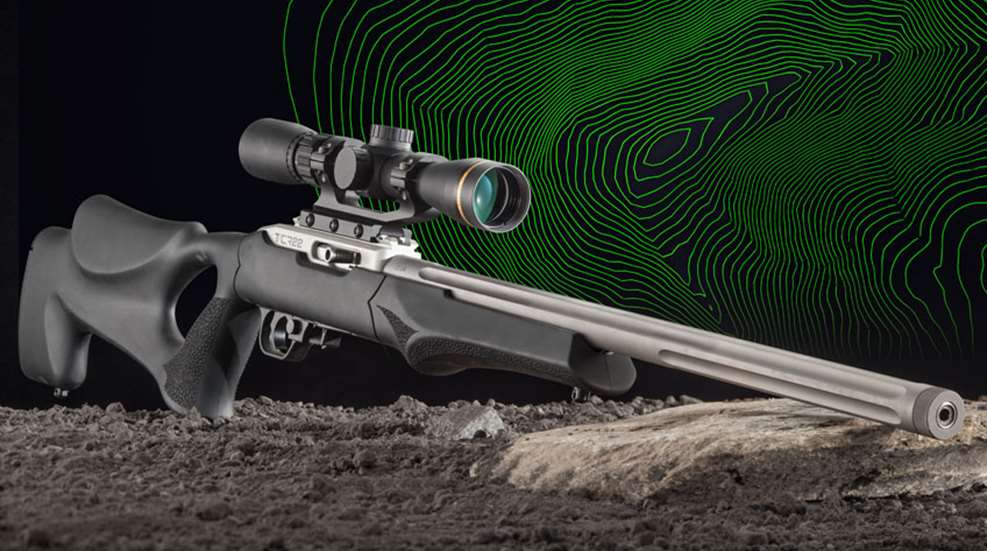
Thompson/Center joined the Smith & Wesson fold back in 2006, with the manufacturing of T/C rifles today occurring alongside S&W production in Springfield, Mass., but it wasn’t until 2018 that the two entities intermingled their product lines with the introduction of Performance Center-branded T/C models.
We previously evaluated the introductory version of the Thompson/Center T/CR22—a general-purpose model wearing a Magpul synthetic stock, iron sights and a lightweight barrel—and we found it to be a capable gun and a value at its MSRP of $399.
So when two Performance Center T/CR22 SKUs, more catered to the specialized applications of competition shooting and small-game hunting, were introduced early last year, at what I felt to be quite reasonable mark-ups relative to the original model, I was curious to see just what that Performance Center label added to the mix.
As a southpaw, I opted to evaluate the ambidextrous Hogue-stocked variant over the right-hand-only thumbhole Altamont-stocked version (Since writing, an additional four models, each sporting a heavy-contour carbon-fiber-wrapped barrel, have been introduced to the T/C Performance Center line).
The T/CR22 is the company’s first autoloading design in many years, and there’s no denying the rifle’s great similarity to Ruger’s Model 10/22—so much so, in fact, that the platform is compatible with nearly all 10/22 components and accessories, tapping into that deep aftermarket of barrels, stocks, triggers, magazines, bolt handles and more.
Even Thompson/Center has already availed itself of this market, as the OEM Hogue buttstock on our Performance Center rifle has been sold as a replacement part for the Ruger 10/22 for years now. Differences between the two guns do exist, however, and more seasoned observers will note a number of modifications made to the design of the T/CR22 by Thompson/Center to help streamline both the operation and maintenance of its rimfire.
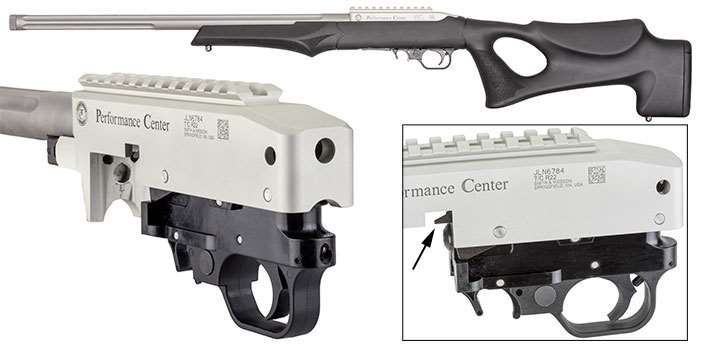
The Performance Center T/CR22 employs a simple blowback operating system that utilizes the energy exerted by ignition gases on the cartridge case to cycle the action, with the mass of the slide and the tension provided by the recoil spring keeping the chamber closed until the bullet can leave the barrel. Machined from 6061 aluminum, and wearing a satin, glass-bead-blasted finish, the receiver is cut with an integral 4.5" (11-slot) section of Picatinny rail for the installation of an optic—the use of which will be mandatory, as the gun doesn’t ship with any other sighting options.
A stainless steel bolt slides smoothly within the receiver, and an enlarged bolt handle makes for fumble-free operation. A spring-loaded extractor is incorporated into the right side of the bolt, and a fixed ejector is found opposite it on the left side of the receiver. Once the barreled action has been freed from the stock and the trigger and bolt assemblies have been removed (all in familiar 10/22 fashion), a 1 cm hole in the rear of the receiver permits straight-line access to the chamber—allowing the bore to be cleaned from breech to muzzle, as is ideal.
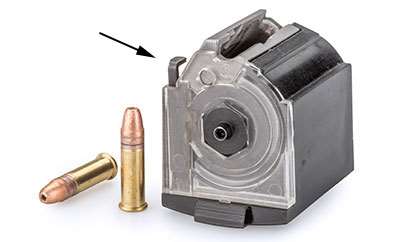
Although the T/CR22’s 10-round rotary magazine shares the same basic footprint as does the 10/22’s, the addition of what Thompson/Center calls the “first round load assist lever” to the rear, left corner of the magazine not only changes its loading procedure, but, more importantly, allows the bolt to lock back on an empty box.
Remaining depressed when ammunition is present, the lever extends upward when the magazine is empty, allowing it to actuate a catch on the left side of the receiver that blocks the forward return of the bolt into battery. The use of this design also means that once a fresh, loaded magazine has been fed into the rifle, the T/CR22 can be charged by simply pulling the bolt handle slightly rearward and allowing spring tension to close the action and chamber the round.
Shooters accustomed to loading 10/22 magazines may find the process of filling a T/CR22 magazine to be a bit foreign at first, as the first-round load-assist lever must be used in order to get the box to load correctly, but it is not a difficult procedure after about 30 seconds of practice. The T/CR22 will work perfectly well with standard 10/22 magazines, although obviously without the bolt-hold-open functionality, and the presence of the lever did not hamper the use of T/CR22 magazines in my 10/22.
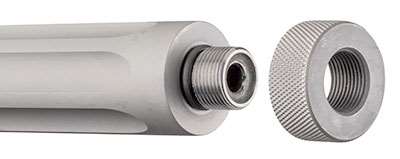
In lieu of the 17", sporter-contour tube of its predecessor, the Hogue-stocked Performance Center model employs a 20", heavy-contour, stainless steel barrel. The longer, heavier barrel takes the length and weight of the gun to 38.5" and 6 lbs., 11 ozs., respectively, compared to the 35" and 4-lb., 6-oz., measurements of the base T/CR22. Button-rifled at a 1:15" twist rate, the barrel measures a consistent 0.92" in diameter along its entire length.
To both decrease weight and increase surface area (thereby speeding heat dissipation), three flutes that run nearly the whole span of the barrel have been cut into its top half, while three more on the bottom half only extend about 7" from the muzzle. The final 0.400" of the barrel is threaded 1/2x28 TPI (industry standard for .22-cal. guns), making the rifle compatible with either a rimfire suppressor or a muzzle device, and included on the gun are a rubber O-ring to provide a gas seal when a barrel accessory is being used and a knurled thread protector for when one is not.
Created with competition shooters and varmint hunters in mind, and thus an apt choice for inclusion on this rifle, the Hogue buttstock used on the test Performance Center T/CR22 is the company’s Tactical Thumbhole model. Overmolded with semi-tacky rubber, the Tactical Thumbhole would be easy to hold onto under the nominal recoil of the .22 Long Rifle cartridge even without the texturing dots added to the pistol grip and the fore-end.
Ambidextrous in design, the stock features a thumbhole pistol grip, a raised comb for proper alignment with the requisite optic, a broad fore-end for sand bag use, a sharp underhook for stabilizing the rear of the rifle with the shooter’s support hand, and both fore and aft sling swivel studs. A generous channel allows the barrel, despite its thick contour, to float freely of the stock, and no sensible amount of force applied to the fore-end could bring the two into contact with each other.
Nearly all of the T/CR22’s operating controls are integrated into the rifle’s trigger assembly, and can be found clustered between the trigger guard and the magazine well. Moving forward from the trigger, first is a crossbolt safety, with a telltale ring of red showing on the left side when the gun is ready to fire.
Next is a manual bolt-hold-open lever that can be pulled rearward while retracting the bolt in order to lock the action open. Ahead of that is a magazine release lever that, when pressed forward, reliably dropped the detachable box from the firearm without requiring assistance from me when the action was open, but needed some help when it was closed.
The polymer single-stage trigger on the Performance Center rifle is identical to the one used in the base T/CR22; using a 10-pull average, my test sample broke at 5 lbs., 2 ozs., after about 1/16" of take-up and slight creep. All in all, it was good enough that it did not detract from what my testing determined to be an outstandingly accurate firearm.
American Rifleman’s 10-shot, five-group protocol at 50 yds. with three loads is a pretty harsh standard by which to judge a rimfire rifle’s worth, yet the Performance Center T/CR22 shined; just one of the 15 combined groups fired during formal accuracy testing exceeded the 1" mark.
All three of the selected loads shot well through the rifle, with CCI’s 40-gr. Mini-Mags averaging 0.84" and Remington’s 40-gr. 22 Target load averaging 0.93", but the clear winner was the 40-gr. TAC-22 ammunition from Norma. Three of the five Norma groups were smaller than either of the other two loads’ tightest groups, for a five-group average of 0.74"—a result that would have been even more impressive if not for one flier that ballooned an otherwise tight nine-shot cluster out to 0.96".
In our previous testing, the general-purpose T/CR22 had managed an average extreme spread of 0.93", while the Performance Center variant bested that with a three-load mean of 0.84"—a result I mostly credit to the heavy-contour barrel. Even after long strings of shooting, including multiple magazine dumps using Ruger’s BX-25, barrel heating never became a factor.
Shooting this rifle felt very familiar to me, as I have Hogue’s Tactical Thumbhole on one of my personal 10/22s at home. When I think about performance in a semi-automatic rimfire rifle, reliability is my chief consideration, and the T/CR22 again delivered. In addition to the three 40-gr. loads detailed above, I also function tested the gun with a 30-gr. hypervelocity ammunition from Aguila and Winchester’s 45-gr. M22 Subsonic load, all of which ran 100 percent without incident.
Our rimfire rifle testing protocol requires that quite a lot of ammunition be expended, I ran a total of around 600 rounds through the T/C, and to get through that many rimfire cartridges without a single issue truly is a credit to both the quality of the firearm and the ammunition involved.
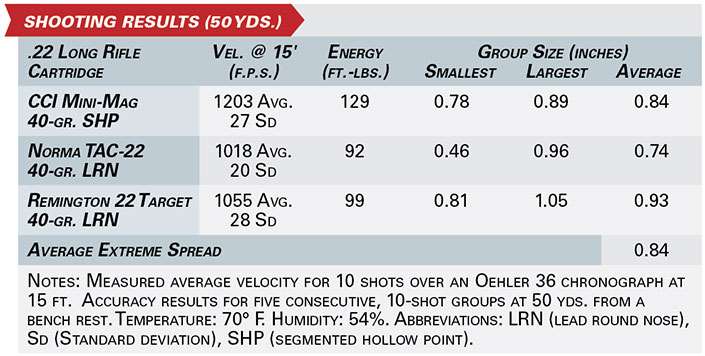
The rimfire rifle is an indispensable part of any firearm collection. Given its user-friendliness (inexpensive, cheap to feed, infinitesimal recoil, easy to shoot) and extreme utility (everything from training new shooters and plinking to small-game hunting and expert-level competition) there’s really no good excuse for anyone reading this to not have at least one .22 stashed away in the safe—and preferably near the front.
But if you don’t, there’s no time like the present to remedy that—and at an MSRP of only $497, the reliability, accuracy and feature set of the Performance Center T/CR22 should place it high on your short list. We tend to think of performance and price as being inseverably linked, and oftentimes that is true, but this rifle—determined by my testing to be wholly worthy of the Performance Center name—demonstrates that efficacy does not need to be expensive.














